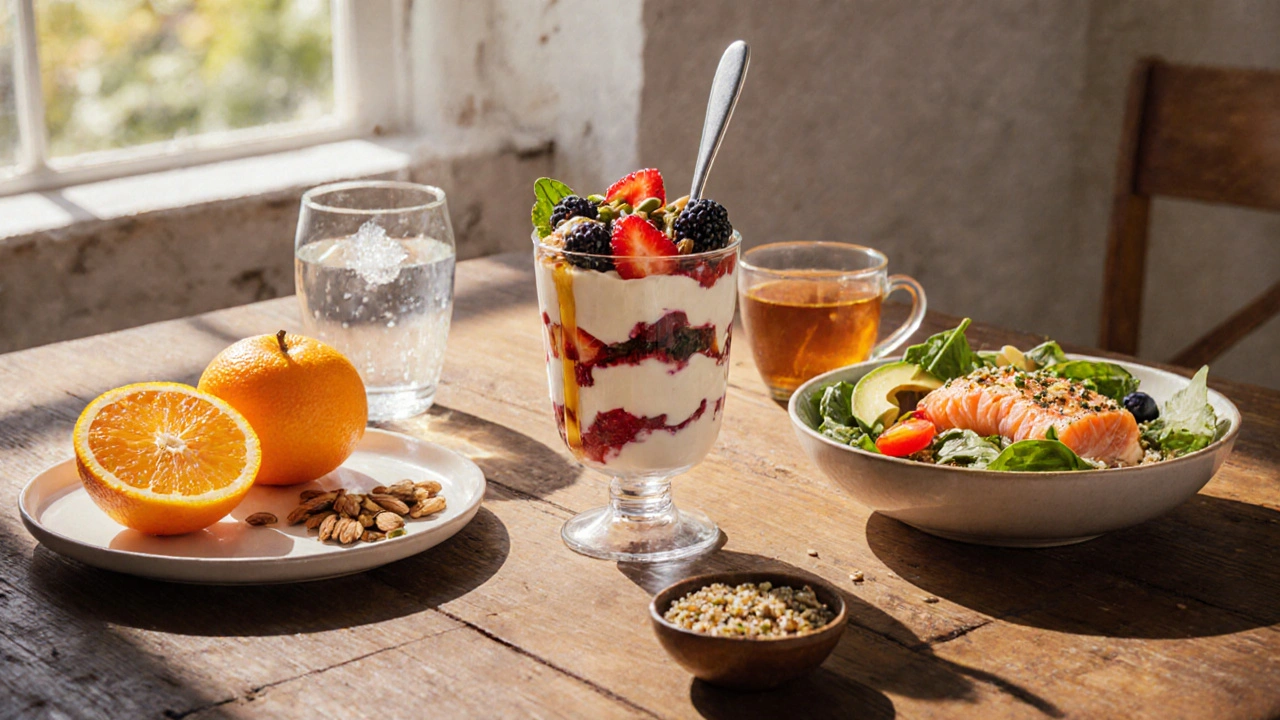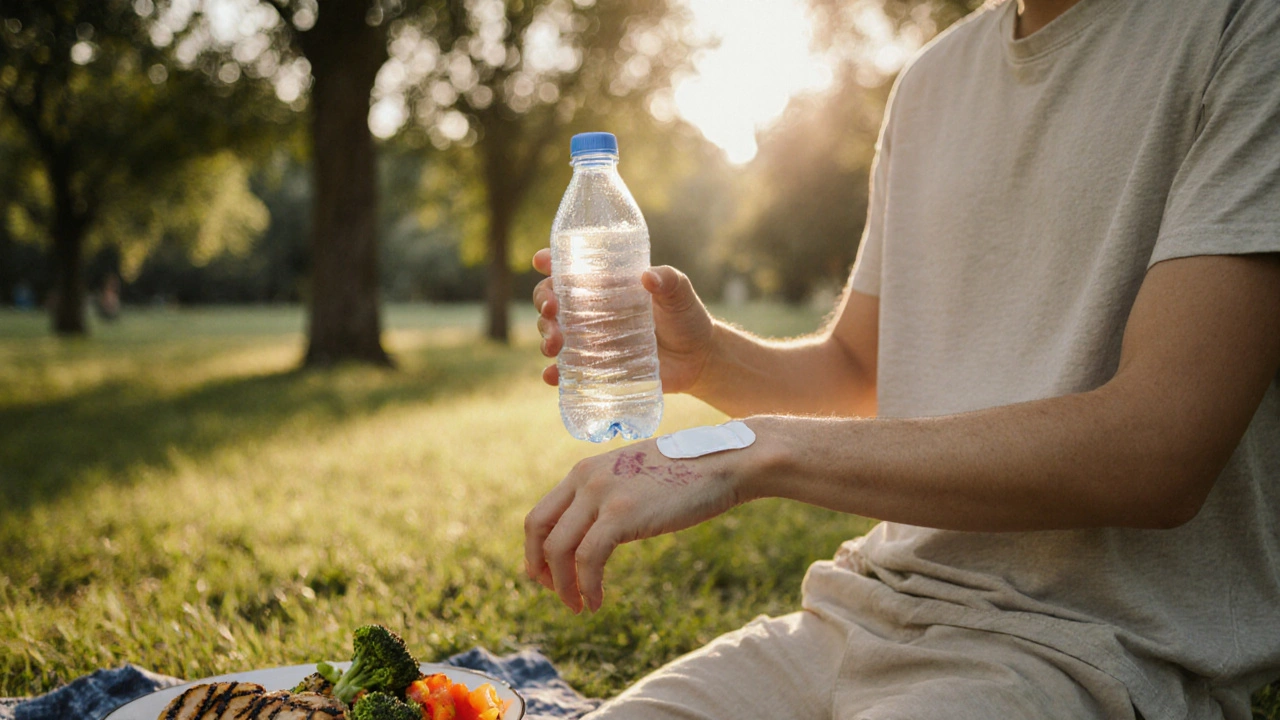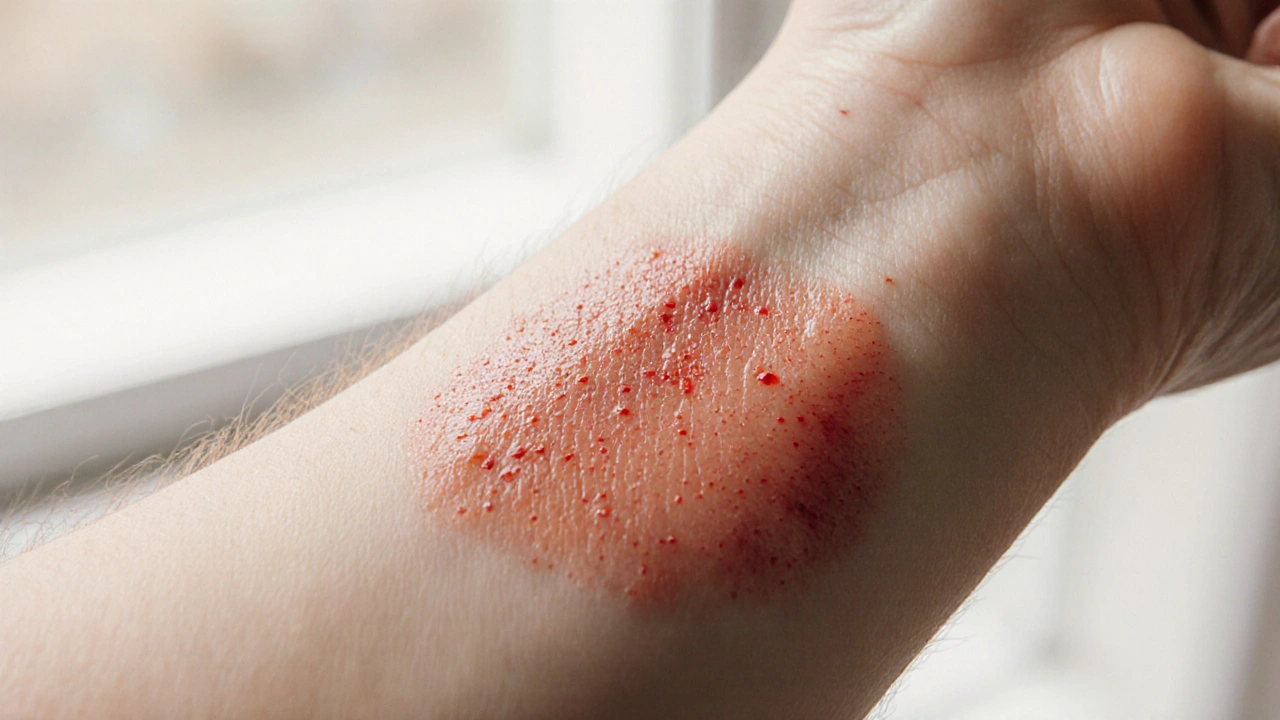Wound Healing Nutrient Calculator
Personalized Healing Nutrition Guide
Determine your exact nutrient needs to speed up abrasion recovery based on your body weight
When a scrape or a road‑rash feels like a small nuisance, the right foods can turn a slow recovery into a quick bounce‑back. Below we unpack how what you eat directly fuels the body’s repair engine, which nutrients matter most, and simple ways to load your plate for faster abrasion healing.
What is an abrasion?
Abrasion is a superficial injury that removes the top layer of skin (the epidermis) and sometimes reaches the dermis. It typically results from friction, a scrape against a rough surface, or a minor cut, causing redness, minor bleeding, and a tender raw patch. Because the damage stays shallow, the body can mend it without stitches, but the healing speed hinges on blood flow, cellular turnover, and, crucially, the nutrients that support tissue rebuild.
Why nutrition matters for skin repair
Skin isn’t a passive barrier; it’s a living organ that constantly regenerates. Every new cell needs building blocks-amino acids, vitamins, minerals, and water. When you feed the body the right ingredients, you give fibroblasts (the cells that lay down collagen) the energy to work faster, reduce inflammation, and protect the new tissue from oxidative stress. In contrast, a diet low in protein or vitamins can stall the process, leaving a scarred patch that lingers.

Key nutrients that speed up abrasion healing
Protein
Protein is the primary building material for new skin cells, enzymes, and immune proteins. Aim for 1.2‑1.5g per kilogram of body weight daily while the wound is active. Good sources include lean poultry, fish, eggs, Greek yogurt, lentils, and tofu. Each gram supplies essential amino acids like lysine and arginine, which directly stimulate collagen synthesis.
VitaminC
Vitamin C acts as a co‑factor for the enzymes that stitch collagen fibers together. Beyond its antioxidant shield, it speeds fibroblast activity. The recommended 90mg for men and 75mg for women jumps to about 200mg during wound healing. Citrus fruits, strawberries, kiwi, bell peppers, and broccoli hit the mark.
Zinc
Zinc is essential for DNA replication and immune cell function, both critical for tissue regeneration. Deficiency can double healing time. Aim for 15mg (men) or 12mg (women) per day, sourced from pumpkin seeds, beef, chickpeas, and oysters.
Omega‑3 fatty acids
Omega‑3 fatty acids moderate inflammation and improve blood flow to the wound site. EPA and DHA from fatty fish (salmon, mackerel) or ALA from walnuts and flaxseed help keep the inflammatory phase from dragging on, which can otherwise delay re‑epithelialization.
Hydration & electrolytes
Hydration maintains skin turgor and transports nutrients to the wound. Drinking 2.5‑3L of water daily (more if active or hot) ensures cells stay pliable. Adding a pinch of sea salt restores electrolytes lost through sweat, supporting optimal cellular function.
Comparison of top wound‑healing nutrients
| Nutrient | Primary Role | Recommended Daily Amount (Healing Phase) | Best Food Sources |
|---|---|---|---|
| Protein | Supplies amino acids for new tissue | 1.2‑1.5g/kg body weight | Chicken, fish, eggs, Greek yogurt, lentils |
| VitaminC | Collagen cross‑linking, antioxidant | ~200mg | Oranges, kiwi, red bell pepper, broccoli |
| Zinc | DNA synthesis, immune support | 12‑15mg | Pumpkin seeds, beef, chickpeas, oysters |
| Omega‑3 | Reduces inflammation, improves circulation | 1‑2g EPA/DHA | Salmon, mackerel, walnuts, flaxseed |
| Hydration | Carries nutrients, keeps skin supple | 2.5‑3L water + electrolytes | Water, herbal teas, coconut water |
Building a wound‑healing friendly diet
A balanced plate that hits the above nutrients doesn’t have to be a chore. Here’s a simple day plan:
- Breakfast: Greek yogurt parfait with mixed berries, a sprinkle of pumpkin seeds, and a drizzle of honey.
- Mid‑morning snack: A sliced orange and a handful of almonds.
- Lunch: Grilled salmon salad (spinach, cherry tomatoes, avocado) dressed with olive oil and lemon juice. Add quinoa for extra protein.
- Afternoon snack: Carrot sticks with hummus (rich in zinc).
- Dinner: Stir‑fried chicken breast, broccoli, and bell peppers over brown rice. Finish with a cup of herbal tea.
- Hydration: Keep a water bottle within reach; aim for a sip every 15‑20 minutes.
Switch the protein source (tofu, lean beef, or beans) and rotate fruit choices to keep meals interesting while still loading up on the key nutrients.

Common pitfalls and myths
1. “More protein is always better.” Over‑consumption can strain kidneys and isn’t necessary beyond the recommended range. Stick to 1.2‑1.5g/kg.
2. “VitaminC pills replace fresh fruit.” Whole foods provide bio‑flavonoids that boost absorption and add antioxidant power that supplements alone can’t match.
3. “If the wound looks clean, nutrition doesn’t matter.” Even a shallow abrasion needs cellular turnover underneath the surface; nutrients keep that process efficient.
4. “Avoid fats to stay healthy.” Healthy fats, especially omega‑3s, are vital for controlling inflammation and promoting blood flow.
5. “Hydration is only about drinking water.” Electrolyte balance-sodium, potassium, magnesium-helps cells transport nutrients. A pinch of sea salt or a splash of coconut water can make a difference.
Quick healing checklist
- Consume 20‑30g protein at each main meal.
- Hit 200mg vitaminC spread across the day.
- Include a zinc‑rich snack daily.
- Eat two servings of omega‑3‑rich foods each week.
- Drink at least 2.5L water; add electrolytes if active.
- Avoid smoking and excess alcohol-they impair collagen formation.
- Keep the abrasion clean, moist (use a non‑adhesive dressing), and protect it from friction.
Frequently Asked Questions
Can I speed up healing by taking extra vitaminC supplements?
Supplementing can help if your diet is low, but the body absorbs vitaminC best from whole foods. Aim for 200mg daily through citrus, berries, and peppers; a 500mg tablet won’t double the benefit and may cause stomach upset.
Is it safe to eat raw fish for omega‑3 benefits while my abrasion is healing?
Yes, as long as the fish is sushi‑grade and sourced from reputable suppliers. Raw fish avoids extra cooking oils and retains full EPA/DHA content, but ensure it’s fresh to avoid food‑borne illness that could complicate healing.
How much protein should I eat if I’m vegan?
Target the same 1.2‑1.5g/kg body weight using plant sources: lentils, chickpeas, tempeh, tofu, quinoa, and nut butters. Pairing legumes with grains (e.g., rice and beans) gives a complete amino acid profile.
Should I apply topical zinc oxide on the abrasion?
Topical zinc oxide acts as a barrier and can soothe irritation, but it doesn’t replace dietary zinc. Use a thin layer under a non‑stick dressing; the systemic intake remains the main driver for tissue repair.
Is dehydration a real risk for slow abrasion healing?
Absolutely. Dehydrated skin loses elasticity, making new cells migrate slower. Aim for the 2.5‑3L water target, and add electrolytes if you’re sweating heavily or have a fever.


The extracellular matrix remodeling cascade is accelerated when dietary leucine and arginine availability exceeds basal thresholds; this upregulates mTOR signaling which in turn enhances keratinocyte proliferation and collagen deposition. Adequate protein intake thus directly modulates fibroblast activity over the proliferative phase of abrasion repair.
When you consider the biochemical pathways involved in tissue regeneration, it becomes evident that a holistic nutritional strategy is not merely an ancillary suggestion but a cornerstone of accelerated abrasion healing; therefore, one should prioritize macro- and micronutrient timing alongside overall caloric adequacy, and this is precisely why I advocate for a structured meal plan that distributes protein roughly every three to four hours, because the intermittent surge of essential amino acids sustains the translational machinery of fibroblasts, thereby maintaining a steady supply of collagen precursors throughout the repair window. Moreover, vitamin C, acting as a cofactor for prolyl and lysyl hydroxylase, must be ingested in doses that exceed the basal dietary reference intake, and the literature consistently shows that a sustained intake of approximately 200 mg per day, sourced from citrus fruits, berries, and peppers, not only enhances hydroxyproline cross‑linking but also mitigates oxidative stress at the wound margins; consequently, the scar tissue that forms is more organized and less prone to hypertrophic proliferation. In addition, zinc's role in DNA synthesis and immune modulation cannot be overstated, and a daily intake of 12‑15 mg, attainable through oysters, beef, and pumpkin seeds, ensures that the proliferative phase proceeds without bottlenecks caused by nucleotide scarcity. Omega‑3 fatty acids, particularly EPA and DHA, serve to temper the inflammatory cascade by giving rise to resolvins and protectins, and a regular intake of 1‑2 g per day, obtained from fatty fish or algae‑based supplements, affords a more balanced inflammatory milieu, thus preventing the prolonged catabolic state that typically delays re‑epithelialization. Hydration, often overlooked, underlies every cellular process, and maintaining a fluid turnover of 2.5‑3 L daily, complemented by electrolytes such as sodium and potassium, guarantees optimal osmotic conditions for nutrient transport and waste removal, which collectively expedite the maturation phase of wound healing. Finally, practical implementation matters: a breakfast of Greek yogurt with mixed berries and a sprinkle of pumpkin seeds provides a synergistic blend of protein, vitamin C, and zinc; a mid‑day salad featuring grilled salmon, leafy greens, and quinoa delivers omega‑3s and additional protein; and consistent water consumption reinforced by a pinch of sea salt ensures the systemic environment remains conducive to rapid tissue repair. By adhering to this comprehensive, evidence‑based protocol, you will transform what might be a week‑long irritation into a matter of days, thereby minimizing downtime and reducing the risk of adverse scarring.
Excellent breakdown! The article nails the importance of protein and vitamin C, and I love how it emphasizes splitting nutrients throughout the day – that really helps with absorption. Also, the hydration tip with electrolytes is spot‑on; I’ve seen people ignore that and wonder why healing stalls. One small suggestion: adding a brief note about the role of iron could be useful, since iron is essential for hemoglobin and oxygen delivery to the wound site. Overall, great practical guide!
Great post, super helpful! I’m already swapping my usual snack for a handful of pumpkin seeds, and the Greek yogurt parfait sounds delicious, especially with the mixed berries – yum! Also, love the tip about sipping water every 15‑20 minutes, that’s something I always forget, haha! Thanks for the clear checklist, I’m going to follow it religiously, and I’m sure my next scrape will heal way faster.